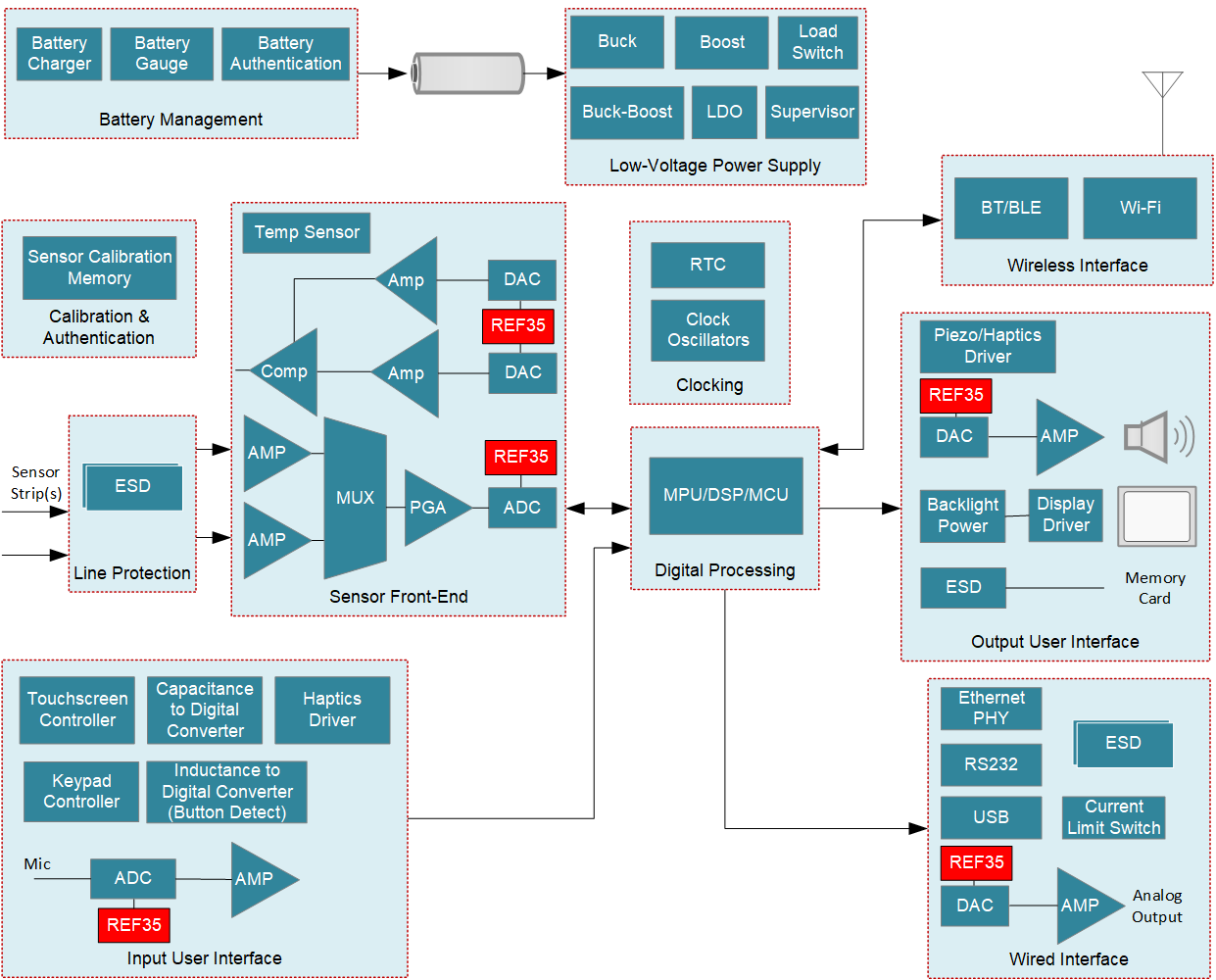-
Accurately measure vital signs with low IQ and a small-form factor
Accurately measure vital signs with low IQ and a small-form factor
Marcoo Z

These days, it feels like the “portable future” is right around the corner. Devices that used to be cumbersome and bulky have become light and portable. I saw this firsthand in personal electronics: cellphones were once heavy and slow; they’re now slim, fast and have an increasingly longer battery life.
I’ve also witnessed this trend in personal health care. It is now possible to check vital signs without having to go to the doctor, partly because of the increasingly small solution size and low power of devices such as blood glucose monitors in the palm of your hand. Blood glucose monitors are experiencing a growing trend in lower power with longer battery life that enables users to have a responsive body vital measurement device.
Blood glucose monitors are devices that have extremely low power and try to push quiescent current (IQ) to the lowest limits possible because they must be able to measure at least 1,000 tests on the same battery which is typically a lightweight 3V button cell. Reaching a battery life that can handle 1,000 tests has become an issue as blood glucose monitors start to become more connected with Bluetooth® and other wireless connectivity (as shown in Figure 1). This is because the increase in wireless connectivity in turn increases power consumption and lowers battery life and increase the need for multiple coin-cell (220mAh) or even AAA batteries (1,000mAh), which have an increase in size and weight.
 Figure 1 Blood Glucose Monitor System
Diagram
Figure 1 Blood Glucose Monitor System
DiagramUnlocking Higher Accuracy
As system power decreases it can become a challenge to maintain a high accuracy, so it is important to make sure that system accuracy remains high; one way to increase accuracy is to have an external voltage reference. An external voltage reference is often practical because there are several techniques – such as oversampling on an analog-to-digital converter (ADC) – that increase the requirements of the reference voltage well above what a typical internal voltage reference can do. The increased requirements on a voltage reference can be a combination of an improved initial accuracy, a lower temperature coefficient, lower noise or even a different voltage reference level. These requirements are typically difficult to achieve in a lower-power application, but the REF35 voltage reference has best-in-class specifications in the low-power domain. It has high accuracy (0.05%), low temperature coefficient (12ppm/°C) and the lowest noise of 3.3ppm pk-pk for a sub-µA reference.
A low-IQ Voltage Reference
The REF35 is one of the world’s lowest-power precision voltage references. The biggest advantage of the REF35 family is its typical 650-nA low supply current requirement, and its ability to source and sink up to 10mA and 5mA of current for an ADC or digital-to-analog converter (DAC) while active. This allows the REF35 to have a very minor impact on overall system power while the system is sampling, as shown in Figure 2.
 Figure 2 Total Power Consumption
Overhead Example (Estimated Percentage)
Figure 2 Total Power Consumption
Overhead Example (Estimated Percentage)The REF35 family also offers wide voltage range options between 1.024V and 5V to benefit applications that use coin-cell batteries. These output voltages offer you the flexibility to get the most out of your ADC by selecting an adequate voltage reference to take advantage of the complete full-scale signal. Higher output voltages also give you the flexibility to power ultra-low-power ADCs such as the ADS7042 that rely on using AVDD as the voltage reference.
Low IQ Is Possible in More Ways than One
TI’s large, low-power voltage reference portfolio includes several low power options aside from the REF35 family. However, there are more ways to save power. One such way would be to use the enable feature of REF35 to limit power consumption while the device is active. When REF35 is in shutdown mode, it can achieve 0.1µA of IQ. It is also possible to use a load switch to turn of sections of the system to lower IQ, which can further bring down the standby current of a blood glucose monitor. Figure 3 shows the power consumption of several popular low-power voltage references.
 Figure 3 Typical IQ of
Several TI Voltage References
Figure 3 Typical IQ of
Several TI Voltage References1.05mm-by-0.84mm WCSP Voltage Reference
The REF35 is also popular in continuous-sampling low-power monitors such as gas analyzers, personal radiation detectors and smoke detectors. These low-power applications continuously sample every minute (up to several hundred samples) while still maintaining a small battery and form factor. For example, due to the harsh temperature conditions in radiation detectors, the REF35 has a low temperature drift of 12ppm/°C from -40°C to 105°C that ensures an accurate reference across temperature. In addition, the REF35 is available in two small-form-factor packages. It is available in a 1.05mm-by-0.84mm WCSP option and a 2.90mm-by-1.5mm DBV SOT23-6 package as shown in Figure 4. This WCSP small form factor also gives you the flexibility to add passives for additional noise filtering and still be smaller than a typical SOT23 package.
 Figure 4 WCSP vs SOT23-6 Size
Comparison
Figure 4 WCSP vs SOT23-6 Size
ComparisonDon’t force yourself to choose between low system power and high system accuracy, as it is possible to increase ADC and DAC accuracy by adding a low-power voltage reference like the REF35. No matter which application you are designing for, TI offers a large portfolio of voltage references that can help you unlock more accuracy in your system.
Additional Resources
- Read the technical articles on how to reduce power consumption in data-acquisition systems and how to ensure precision in automated processes.
- Download the “Tips and tricks for designing with voltage references” e-book.
IMPORTANT NOTICE AND DISCLAIMER
TI PROVIDES TECHNICAL AND RELIABILITY DATA (INCLUDING DATASHEETS), DESIGN RESOURCES (INCLUDING REFERENCE DESIGNS), APPLICATION OR OTHER DESIGN ADVICE, WEB TOOLS, SAFETY INFORMATION, AND OTHER RESOURCES “AS IS” AND WITH ALL FAULTS, AND DISCLAIMS ALL WARRANTIES, EXPRESS AND IMPLIED, INCLUDING WITHOUT LIMITATION ANY IMPLIED WARRANTIES OF MERCHANTABILITY, FITNESS FOR A PARTICULAR PURPOSE OR NON-INFRINGEMENT OF THIRD PARTY INTELLECTUAL PROPERTY RIGHTS.
These resources are intended for skilled developers designing with TI products. You are solely responsible for (1) selecting the appropriate TI products for your application, (2) designing, validating and testing your application, and (3) ensuring your application meets applicable standards, and any other safety, security, or other requirements. These resources are subject to change without notice. TI grants you permission to use these resources only for development of an application that uses the TI products described in the resource. Other reproduction and display of these resources is prohibited. No license is granted to any other TI intellectual property right or to any third party intellectual property right. TI disclaims responsibility for, and you will fully indemnify TI and its representatives against, any claims, damages, costs, losses, and liabilities arising out of your use of these resources.
TI’s products are provided subject to TI’s Terms of Sale (www.ti.com/legal/termsofsale.html) or other applicable terms available either on ti.com or provided in conjunction with such TI products. TI’s provision of these resources does not expand or otherwise alter TI’s applicable warranties or warranty disclaimers for TI products.
Mailing Address: Texas Instruments, Post Office Box 655303, Dallas, Texas 75265
Copyright © 2024, Texas Instruments Incorporated